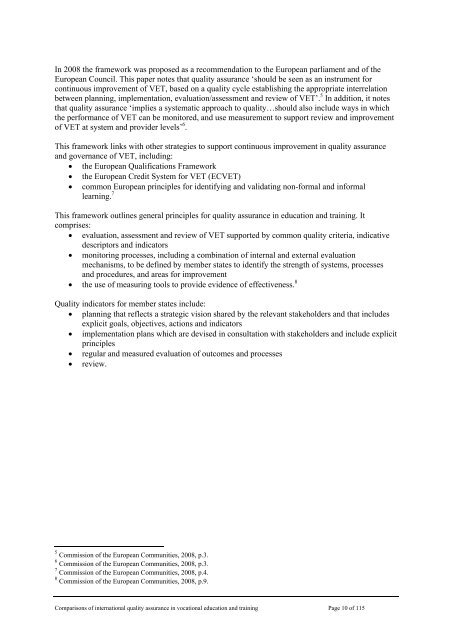Review - Department of Innovation, Industry, Science and Research
Review - Department of Innovation, Industry, Science and Research
Review - Department of Innovation, Industry, Science and Research
You also want an ePaper? Increase the reach of your titles
YUMPU automatically turns print PDFs into web optimized ePapers that Google loves.
In 2008 the framework was proposed as a recommendation to the European parliament <strong>and</strong> <strong>of</strong> the<br />
European Council. This paper notes that quality assurance ‘should be seen as an instrument for<br />
continuous improvement <strong>of</strong> VET, based on a quality cycle establishing the appropriate interrelation<br />
between planning, implementation, evaluation/assessment <strong>and</strong> review <strong>of</strong> VET’. 5 In addition, it notes<br />
that quality assurance ‘implies a systematic approach to quality…should also include ways in which<br />
the performance <strong>of</strong> VET can be monitored, <strong>and</strong> use measurement to support review <strong>and</strong> improvement<br />
<strong>of</strong> VET at system <strong>and</strong> provider levels’ 6 .<br />
This framework links with other strategies to support continuous improvement in quality assurance<br />
<strong>and</strong> governance <strong>of</strong> VET, including:<br />
• the European Qualifications Framework<br />
• the European Credit System for VET (ECVET)<br />
• common European principles for identifying <strong>and</strong> validating non-formal <strong>and</strong> informal<br />
learning. 7<br />
This framework outlines general principles for quality assurance in education <strong>and</strong> training. It<br />
comprises:<br />
• evaluation, assessment <strong>and</strong> review <strong>of</strong> VET supported by common quality criteria, indicative<br />
descriptors <strong>and</strong> indicators<br />
• monitoring processes, including a combination <strong>of</strong> internal <strong>and</strong> external evaluation<br />
mechanisms, to be defined by member states to identify the strength <strong>of</strong> systems, processes<br />
<strong>and</strong> procedures, <strong>and</strong> areas for improvement<br />
• the use <strong>of</strong> measuring tools to provide evidence <strong>of</strong> effectiveness. 8<br />
Quality indicators for member states include:<br />
• planning that reflects a strategic vision shared by the relevant stakeholders <strong>and</strong> that includes<br />
explicit goals, objectives, actions <strong>and</strong> indicators<br />
• implementation plans which are devised in consultation with stakeholders <strong>and</strong> include explicit<br />
principles<br />
• regular <strong>and</strong> measured evaluation <strong>of</strong> outcomes <strong>and</strong> processes<br />
• review.<br />
5 Commission <strong>of</strong> the European Communities, 2008, p.3.<br />
6 Commission <strong>of</strong> the European Communities, 2008, p.3.<br />
7 Commission <strong>of</strong> the European Communities, 2008, p.4.<br />
8 Commission <strong>of</strong> the European Communities, 2008, p.9.<br />
Comparisons <strong>of</strong> international quality assurance in vocational education <strong>and</strong> training Page 10 <strong>of</strong> 115
















